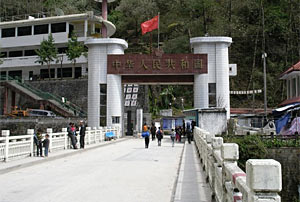
The “Friendship Bridge” at the Tibet-Nepal Border.
According to ICT sources in Dram, Royal Nepalese Army (RNA) personnel from the Tatopani area arrested three Tibetans approximately 20 kilometers south of the Nepal-Tibet border. The army personnel transported the refugees in a van back to the border and turned them over to Nepalese immigration officials. The Department of Immigration officials reportedly walked them over the Friendship Bridge and handed them over to Chinese border security.
On January 9, Radio Free Asia reported that three groups of refugees, 21 in total, have been deported by Nepalese security at the border. ICT has reported extensively on the brutal treatment that these Tibetan refugees receive upon being handed back to Chinese authorities and China’s new prison, designated specifically for those refugees caught at the border.
During meetings with an ICT-sponsored Congressional staff delegation to Kathmandu in January, senior Nepalese government officials reiterated their commitment to honor Nepal’s policy of non-refoulement and humanitarian treatment of refugees. The Nepalese government officials claimed to be unable to confirm the deportation of the 21 refugees, but they indicated that such events were possible as a result of poor communication and a lack of understanding of the government’s policy by the security forces operating in the border areas.
The Home Ministry has not, however, made any attempt to provide written copies of the policy to personnel or commanders posted in the border areas.
Nepalese officials also indicated that they were under pressure from China to enforce Nepal’s immigration laws in the case of Tibetans, while Western countries – including the U.S. – insist that Nepal uphold its commitment of non-refoulement and safe transit to Kathmandu for Tibetan refugees.
Since the escalation of the Maoist insurgency two years ago, border security at the Friendship Bridge area in Nepal has come under the jurisdiction of the Unified Command, a grouping of Nepalese armed police, police and army units who take orders from an RNA commander. The RNA functions under the Defense Ministry while the police and Immigration Department function under the Home Ministry.
According to a senior RNA officer in Tatopani, army personnel have standing orders to hand any Tibetans who do not posses valid passports over to immigration authorities. Tibetan refugees nearly always dispose of all personal identification before crossing the Tibet-Nepal border in case Chinese border security apprehends them.
“While it is conceivable that the RNA commanders are not aware of the government’s policy on Tibetan refugees, immigration officials are under the Home Ministry’s jurisdiction and should be fully aware of the policy,” said Kelley Currie, ICT Director of Government Relations, who traveled with the Congressional staff delegation.
“The fact that these Tibetans passed through Immigration Department custody on their way to deportation raises serious questions about the sincerity of Nepal’s commitment to its official policy of non-refoulement,” said Currie.
“ICT once again calls on the Nepalese government to communicate this policy, in writing, to personnel in the border areas as soon as possible.”
Immigration officials have told ICT human right monitors on separate occasions in the last two years that if a Tibetan is arrested at the border and does not specifically ask for asylum or claim to be a refugee, Nepalese immigration will hand that individual over to Chinese border police. Past incidents have shown that Nepalese border authorities have difficulty communicating with Tibetan refugees. Moreover, they lack the proper training to determine if a Tibetan is a bona fide refugee or an asylum seeker, and Nepal’s own policy recognizes that this responsibility should rest with the Office of the United Nations High Commissioner for Refugees (UNHCR) in Kathmandu.
“The Nepalese government cannot have it both ways – they have made a commitment to the international community that they will not force Tibetans back into Chinese custody, yet incidents of refoulement continue,” said Currie.
“It is time to take some concrete measures to ensure that the personnel in the border areas – both security forces and immigration officials – are aware of the policy and committed to enforcing it,” Currie said.
“What has been happening at the border region over last several weeks suggests that forcible repatriation, not humanitarian treatment via UNHCR, is the policy Nepal is practicing.”

